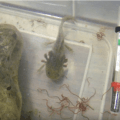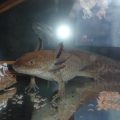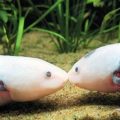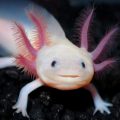Table of Contents
Despite their amazing regenerative abilities, axolotls still need an environment that is conducive for them to survive and breed. So if you’re considering of getting one and set up a tank at home, then you need to do your homework and understand what makes a good axolotl care tank. Here’s a quick rundown of the important things you need to have for your axolotl pet.
The Tank
Though they’re cute and small when young, they can be quite large when they reach adult stage or sexual maturity, which is around 18-24 months. By this time, they can reach 6 to 18 inches in length. Though 9 inches is the more common, and 12 inches is quite rare. Thus, you definitely need a tank that can hold up to 15 to 20 gallons of water. Of course, the tank doesn’t have to be full, just deep enough to accommodate a full-length axolotl.
A water filter will make the tank easier to clean and maintain. Obviously, without a filter, you will need to change the water more frequently. When using a filter however, set the filtration rate at ‘slow’ level and make sure you avoid strong that create strong current to the tank, as this may disturb and cause stress to your pet. You can also add a siphon at the bottom of the tank and change 20% water of the water weekly. Never fully change the water, as sudden change in water chemistry may stress axolotls as well.
Temperature and Light
Keep the tank in cool room, away from direct sunlight. Also, water of the tank should be kept cool, around between 57˚ -68˚ F (14˚ -20˚ C). Never allow the water to go anywhere above 75˚ F (24˚ C).
Axolotl tank doesn’t need any special lighting. As a matter of fact, they don’t like direct light, as they don’t have eyelids that can protect their eyes. If you room is well-lit, you can also use decors such as aquarium castles or half flower pot for axolotls to hide.
Gravel
Coarse gravel is the perfect gravel for axolotl tanks, as any smaller gravel, such as fine gravel, may get ingested by the axolotls during their feeding time, and can be fatal. Some pet owners leave their tank bare at the bottom, but this may cause stress to the axolotls, as their feet don’t have anything to grip on for walking.
Feeding Your Axolotls
Axolotls are carnivorous, and in the wild, they normally eat worms, snails, crustaceans, small fish, and other small amphibians. For the tank however, you can give them brine shrimp, blood worms, earthworms (don’t use wild caught worms, as they may carry parasites dangerous for your axolotl), commercial fish pellets such as salmon pellets and trout pellets, beef strips or liver strips.
Don’t over feed your axolotl care. Also, try to balance their diet by varying their food. Any uneaten food should be removed from the tank daily.






 Author and long-time animal lover. Sharing knowledge on pet care through experience and the written word.
Author and long-time animal lover. Sharing knowledge on pet care through experience and the written word.